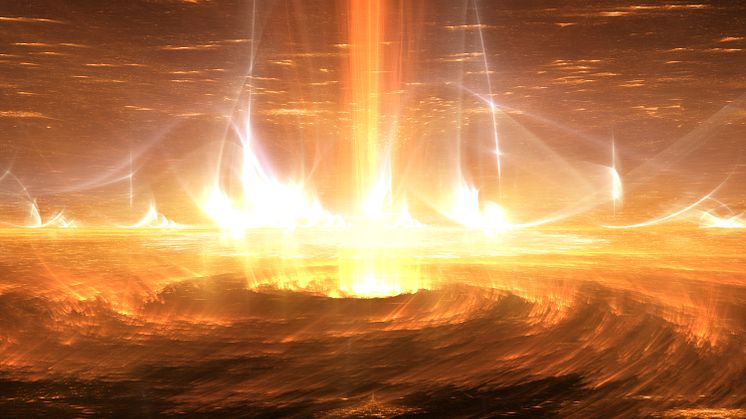
News -
Details of UK-led solar science mission revealed at National Astronomy Meeting
Named after a Celtic goddess of the Sun, SULIS is a UK-led solar science mission, designed to answer fundamental questions about the physics of solar storms.
The mission consists of a cluster of small satellites and will carefully monitor solar storms using state-of-the-art UK technology, as well as demonstrating new technologies in space.
Lead Investigator on the project, Dr Eamon Scullion of Northumbria University, will reveal plans for the mission on Wednesday, 3 July at the Royal Astronomical Society's National Astronomy Meeting in Lancaster.
Once funded, the mission will study the nature of solar eruptions, and track huge magnetic clouds of charged gas as they travel at high speed on a collision course with Earth.
"SULIS will apply high definition remote sensing in 3D to help space scientists finally understand what these magnetic clouds of charged gas are made of, how much matter they contain, what causes their eruption, how fast they are travelling and, most importantly, how damaging they could be to Earth" explains Dr Scullion.
Solar storms occur when the Sun releases enormous bursts of energy as solar flares, launching huge magnetic clouds of charged gas, known as coronal mass ejections. It is the interaction of these charged particles with the Earth's atmosphere that results in aurora, but solar storms can also have a more significant impact on Earth, causing global mobile phone or GPS disruption, radio blackouts, and satellite failures.
The coronal magnetic field is one of the most important physical properties of the solar atmosphere and yet it is one of the least explored. SULIS will include instruments to directly measure the magnetic field of the solar corona for the first time, with three pairs of formation-flying coronagraphs in orbit around the Sun. The first pair will be put into Earth orbit, with the other two pairs to be positioned ahead of, and behind, Earth in its orbit for a mission lifetime of 10 years.
Severe space weather is included on the UK National Risk Register, meaning government departments including military, energy, civil aviation, and transport must plan for this risk. "Solar storms are unavoidable" says Scullion, "but with SULIS we will learn about their basic building blocks in order to more accurately forecast when the next 'big one' will arrive. Having advanced warnings will enable us to take steps to minimise the impact".
On 2 July 2019, SULIS Co-Investigator Dr Huw Morgan, will be part of a team of solar scientists from Aberystwyth University visiting Chile to observe the total solar eclipse. The eclipse provides ideal conditions for testing a state-of-the-art compact hyperspectral imager, which is expected to become incorporated into the SULIS mission on one of satellite pairs. Dr Morgan says, "The SULIS consortium are now awaiting the outcome of the eclipse observing run with high expectations for spectacular HD images of the solar corona".
SULIS is not only designed to be a space science mission, but also to demonstrate technology for precision alignment of small satellites flying in formation, and future communications.
Precision manoeuvring in formation-flying is a challenge for satellite constellations and is crucial for maintaining a functioning coronagraph in space. The coronagraph is essentially an artificial eclipse created by one satellite in a pair eclipsing the Sun with respect to the view of the other satellite. This eclipsing is required in order to block out the bright light of the Sun surface in order to detect and measure the properties of the faint light coming only from the corona. SULIS will investigate the nature of the magnetic field in the corona through inspecting subtle changes in the properties of the coronal light itself.
The mission will also demonstrate the use of laser power transfer in space and laser communications in Low Earth Orbits (i.e. for both inter-satellite communications and satellite-to-Earth communications). This is essential for small satellites with instruments capable of recording vast amounts of data, which either require more efficient ways to store large volumes of data locally, or mechanisms for moving data off the satellites extremely rapidly to avoid hardware and data telemetry issues.
On the SULIS mission, one of the satellites in the formation-flying pair will be shadowed by the other, meaning that the partially eclipsed satellite will require some additional power. This will be done through a laser power exchange with the satellite that is in permanent sunlight in order to carry out all its functions.
The ability to transfer power to otherwise "dead" satellites could be highly useful for future small satellite cluster missions, increasing their longevity, and helping to manage the ever-growing space debris problem.
"We are excited to be developing a mission to expand the UK's role in solar physics" says Scullion. "The SULIS mission complements existing and proposed operational space weather missions from Nasa and Esa and will help pave the way for future space weather instruments".
Find out more about Northumbria's Department of Mathematics, Physics and Electrical Engineering and Extreme Environments multidisciplinary research theme.





